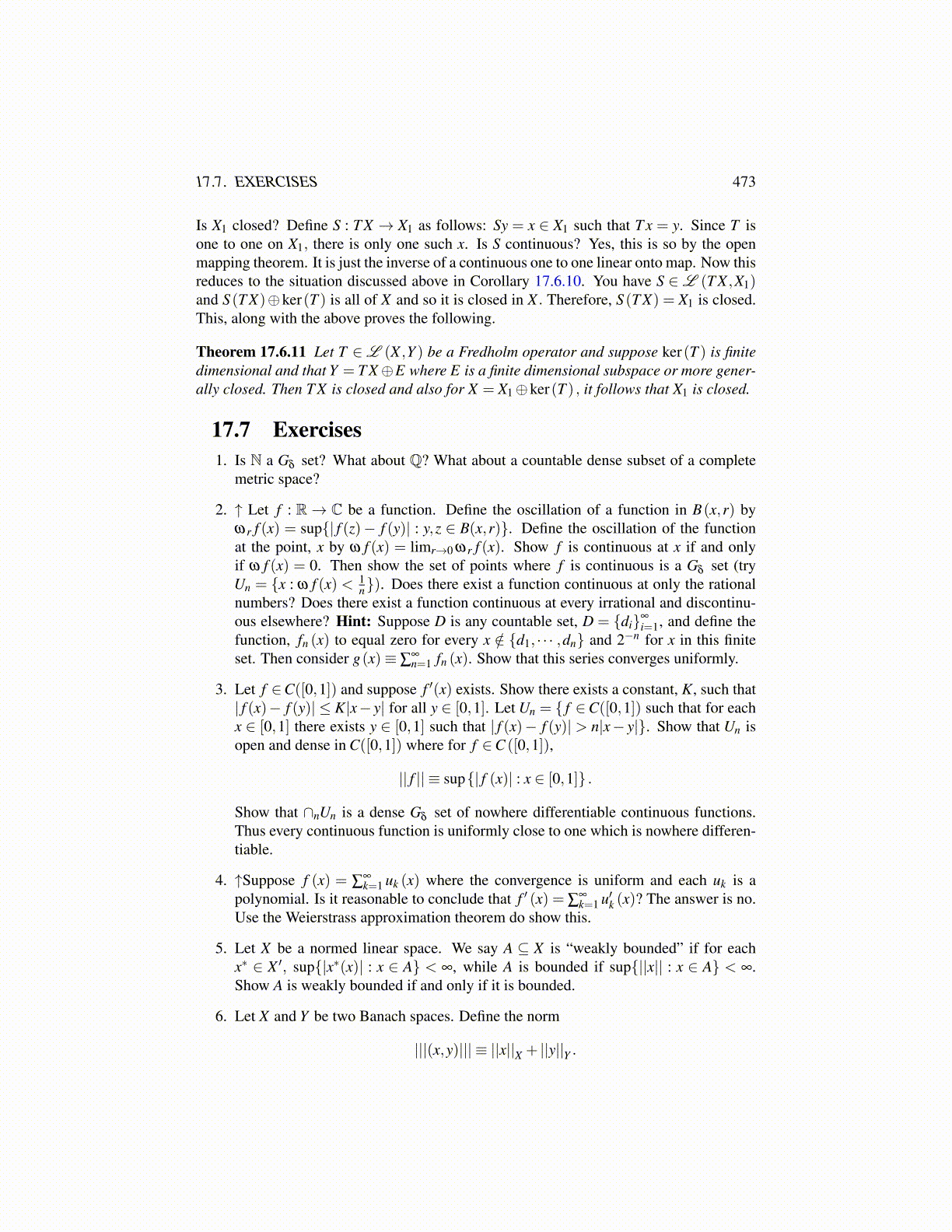
17.7. EXERCISES 473
Is X1 closed? Define S : T X → X1 as follows: Sy = x ∈ X1 such that T x = y. Since T isone to one on X1, there is only one such x. Is S continuous? Yes, this is so by the openmapping theorem. It is just the inverse of a continuous one to one linear onto map. Now thisreduces to the situation discussed above in Corollary 17.6.10. You have S ∈L (T X ,X1)and S (T X)⊕ker(T ) is all of X and so it is closed in X . Therefore, S (T X) = X1 is closed.This, along with the above proves the following.
Theorem 17.6.11 Let T ∈L (X ,Y ) be a Fredholm operator and suppose ker(T ) is finitedimensional and that Y = T X⊕E where E is a finite dimensional subspace or more gener-ally closed. Then T X is closed and also for X = X1⊕ker(T ) , it follows that X1 is closed.
17.7 Exercises1. Is N a Gδ set? What about Q? What about a countable dense subset of a complete
metric space?
2. ↑ Let f : R→ C be a function. Define the oscillation of a function in B(x,r) byωr f (x) = sup{| f (z)− f (y)| : y,z ∈ B(x,r)}. Define the oscillation of the functionat the point, x by ω f (x) = limr→0 ωr f (x). Show f is continuous at x if and onlyif ω f (x) = 0. Then show the set of points where f is continuous is a Gδ set (tryUn = {x : ω f (x) < 1
n}). Does there exist a function continuous at only the rationalnumbers? Does there exist a function continuous at every irrational and discontinu-ous elsewhere? Hint: Suppose D is any countable set, D = {di}∞
i=1, and define thefunction, fn (x) to equal zero for every x /∈ {d1, · · · ,dn} and 2−n for x in this finiteset. Then consider g(x)≡ ∑
∞n=1 fn (x). Show that this series converges uniformly.
3. Let f ∈C([0,1]) and suppose f ′(x) exists. Show there exists a constant, K, such that| f (x)− f (y)| ≤ K|x− y| for all y ∈ [0,1]. Let Un = { f ∈C([0,1]) such that for eachx ∈ [0,1] there exists y ∈ [0,1] such that | f (x)− f (y)| > n|x− y|}. Show that Un isopen and dense in C([0,1]) where for f ∈C ([0,1]),
|| f || ≡ sup{| f (x)| : x ∈ [0,1]} .
Show that ∩nUn is a dense Gδ set of nowhere differentiable continuous functions.Thus every continuous function is uniformly close to one which is nowhere differen-tiable.
4. ↑Suppose f (x) = ∑∞k=1 uk (x) where the convergence is uniform and each uk is a
polynomial. Is it reasonable to conclude that f ′ (x) = ∑∞k=1 u′k (x)? The answer is no.
Use the Weierstrass approximation theorem do show this.
5. Let X be a normed linear space. We say A ⊆ X is “weakly bounded” if for eachx∗ ∈ X ′, sup{|x∗(x)| : x ∈ A} < ∞, while A is bounded if sup{||x|| : x ∈ A} < ∞.Show A is weakly bounded if and only if it is bounded.
6. Let X and Y be two Banach spaces. Define the norm
|||(x,y)||| ≡ ||x||X + ||y||Y .